Claypit Hill Playground
Claypit Hill Playground Renovation
Prior to 2022 this playground featured a hybrid surface made of wood chips, concrete, and bonded rubber tiles. The renovation removed wood chips and resurfaced entire footprint with unitary surfacing to promote accessibility and inclusivity. The renovation also replaced the main structures. Finally, the improvements added new accessible, sensory and inclusive elements around the main structure. The adjacent basketball court was resurfaced in 2020. Many thanks to the Community Preservation Committee, Recreation Commission, the teachers, students, Claypit Hill PTO families, school principals, playground consultants and Town officials who made this project possible-- but also to the KIDS who helped make sure the new playground will be FUN.
Here's a video of the new We-Go-Round in action. (YouTube)
Here's a video of the Venti in action (YouTube)
This project is funded by the citizens of Wayland through the Community Preservation Act, donations by the Wayland Public School Foundation the BASE Program and the Claypit Hill School PTO and the Recreation Department with state funding earmarked for recreation.
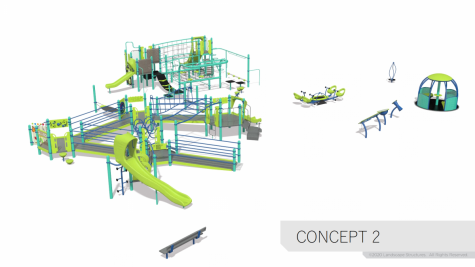
Before: This photo shows existing conditions at the Claypit Hill Playground. Installed in 1997, Claypit Hill Playground was accessible by an asphalt sidewalk and curb that ran the length of the playground from the school building to the basketball court. Within the playground, there were concrete pathways (not in fall zones) and a structural ramp that led to the upper level of the playground. There is a hybrid of surfaces composed of concrete, wood fiber, and bonded rubber playground tiles which lead to a wheelchair transfer station. The loose-fill wood fiber covers a majority of the playground, and leads to the four tire swings and an existing swing set with six standard strap swings.

After:
Purpose
This project will improve the outdoor recreation areas to be more accessible for all users. The results would allow for fun, inclusive, physical and social interactions for all children in Wayland. Success of this project would be measured by more people using parks for healthy outdoor recreation, regardless of ability.
Relevance / Community Need
Accessible playgrounds doesn’t only benefit children, because children rarely use playgrounds alone. Accessible participation opportunities also benefit parents, relatives and caregivers who may have a disability, people with temporary conditions such as broken bones, eye surgeries, or even advanced pregnancy may find it easier to get to and utilize an accessible playground. Most significantly, inclusive play between children with disabilities and children without disabilities is threatened when the playground does not have accessible equipment and surfaces. Senior citizens who may experience stiffness or limited range of motion due to arthritis have an easier time participating at an accessible playground with children and grandchildren. Physical barriers also can prohibit adult caregivers with disabilities from engaging with their children and/or responding when a child is in need of assistance Although the existing conditions meet minimum access requirements, access is currently known to be challenging for users; the surfaces are preventing all users from experiencing the parks equally.
Rationale for CPA Fund Application
Just as water, roads, and public safety are considered essential public services, parks are vitally important to establishing and maintaining the quality of life in a community, ensuring the health of families and youth, and contributing to the overall well-being of residents in town. The National Recreation and Park Association (NRPA) conducted a survey in 2018 that concluded “9 in 10 Americans say communities should offer all-inclusive play options at playgrounds.”
Improving accessibility at public playgrounds qualifies as an allowable use of (Community Preservation Act) CPA Funds under both Open Space and Recreation. In keeping with the Recreation Department’s mission, as we strive to offer ‘Something for Everyone’ as well as the goals of the CPA to provide access whenever possible to the greatest number of residents, the Wayland Recreation Department is requesting funding for accessibility improvements at two public playgrounds in Wayland. The department has prioritized two playgrounds, both of which have frequent and active users that are experiencing challenges with accessibility.
Stakeholders / Community Support
The Recreation Department has been working with several Wayland families with students who use wheelchairs, the Superintendent and Principals, the BASE Afterschool Program, and the school PTOs supporting these efforts. Other major stakeholders include the park's abutters, the neighborhood, Little League Baseball and Wayland Youth Soccer who use the surrounding recreation areas regularly.
Improving Accessibility & Inclusivity
Replacing the existing loose-fill wood fiber with another material will improve accessibility to not just meet but to exceed the minimum requirements. This project proposes to replace existing surfaces with a poured-in-place rubber surfacing or a similar material to make areas more accessible to the greatest possible number of users through complete unitary resurfacing. In addition to replacing the surfacing, if funding allows, the entire main play structure could be replaced and upgraded, plus afford the addition of several other accessible and inclusive play elements and amenities. There is also an opportunity to resurface the outdoor basketball which has not been done in almost twenty years.
INCLUSIVE PLAY EQUIPMENT
Universally designed playgrounds are created to be accessible to all children. Three components help create inclusive play: physical accessibility, age and developmental appropriateness, and sensory-stimulating activity. Combined, these will create an inclusive play environment that meets the needs of all children in the same place in a variety of ways. Children of all abilities will come together to play and imagine—making them equal through play.
DEVELOPMENTAL BENEFITS:
Sensory: Auditory, Proprioception, Tactile, Visual
Motor Skills: Eye-Hand Coordination, Motor Planning
Cognitive Skills: Problem Solving, Strategic Thinking
Social/Emotional Skills: Cooperation, Imaginative Play, Social Skill Development
Site Priority
All twelve of Wayland’s public playgrounds were evaluated through a certified playground inspection, and then assessed with the following criteria: level of use, quality of existing equipment, types of users, and proximity to a school and/or other venues programmed for recreation. Of the twelve playgrounds in Wayland, ultimately (1) the Claypit Hill Upper Playground and (2) the Happy Hollow front Playground rose to the top of the priority list. The Claypit Hill Playground is located on a public school property that also features parks and recreation venues: seven youth soccer fields, an outdoor basketball court, a preschool playground, and two baseball/softball diamonds. Claypit is a heavily programmed park by both the Recreation Department and community groups, in addition to the general school population, it is home to summer camps and the BASE Program.
Project Info
Designs & Concepts | December 2019 | Consultations with Playground Inspectors |
Funding | Early 2020 | Over $400,000 from the Community Preservation Act (CPA) Funds |
Approval at 2020 ATM | September 12, 2020 | Town Meeting voters approved the funding at 2020 ATM on September 12, 2020 |
Equipment | October 2021 - August 2022 | Landscape Structures Inc. |
Contractor & Surfacing | Installation & Poured-In-Place | Green Acres Landscape & Construction Co., Inc |
|
Maintenance
In addition to improving safety and accessibility with new surfacing, the goal for the project is to be one that is durable and low-maintenance. Playgrounds can have “unitary” playground surfaces (which include seamless, uniform surfaces such as poured-in-place rubber surfacing, rubber tiles, and bonded rubber mulch) “loose-fill” playground surfacing (like engineered wood fiber or rubber mulch); Or playgrounds can have a hybrid of surfaces, but sometimes users find safety concerns and maintenance needs where the two surfaces interface. The Recreation and Department of Public Works - Parks Division use operating funds to maintain public recreation areas that do not generate revenue.
Selecting Surface Materials
Accessible play area surfacing must be slip-resistant, firm and stable, allow all users to approach and enter the playground safely, and attenuate the impact from falls. All must attenuate falls from critical fall heights, defined as the “maximum height from which a life-threatening head injury would not be expected to occur.” The Recreation Commission reviewed over 10 types of materials before selecting to use a poured-in-place unitary surface, below is a summary of some of the playground materials:
| SURFACE OPTION | DESCRIPTION |
|---|---|
| Poured-in-place (PIP) Rubber | 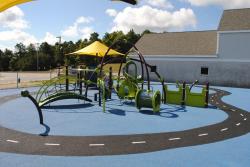 The most accessible playground surface on the market is poured-in-place rubber. It absorbs falls from the greatest height and wheelchairs can easily roll over it. Poured-in-place requires little to no ongoing maintenance but is initially expensive to install. It can be made with recycled post-industrial EPDM (Ethylene Propylene Diene Monomer) rubber and polyurethane. Rubber and urethane components are mixed and applied on site, it’s easy to add colors, logos, or geometric shapes into the surface. The most accessible playground surface on the market is poured-in-place rubber. It absorbs falls from the greatest height and wheelchairs can easily roll over it. Poured-in-place requires little to no ongoing maintenance but is initially expensive to install. It can be made with recycled post-industrial EPDM (Ethylene Propylene Diene Monomer) rubber and polyurethane. Rubber and urethane components are mixed and applied on site, it’s easy to add colors, logos, or geometric shapes into the surface. |
| Poured-in-place (PIP) Cork |
This material has not yet been reviewed by the MAAB. |
| Turf | 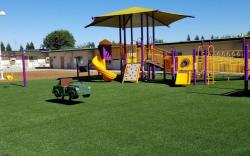 Accessible turf installed over cushioning with properly draining bases. Some of these surfaces do not absorb falls from as high as poured-in-place. Turf is less expensive than poured-in-place and easier to install. Low-maintenance. Accessible turf installed over cushioning with properly draining bases. Some of these surfaces do not absorb falls from as high as poured-in-place. Turf is less expensive than poured-in-place and easier to install. Low-maintenance. |
| Interlocked Rubber Mats and Tiles |
The Town installed rubber mats at two playgrounds in 2019 as a temporary solution to accessibility and found mixed results. |
| Bonded Wood Fiber | 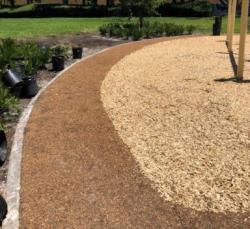 Wood chips are adhered to make the surface accessible to people using mobility devices. This surfacing material is less expensive than poured-in-place but costlier than regular wood chips. Bonded wood chips also require less routine maintenance than engineered wood chips or shredded rubber. Sometimes these surfaces are prone to fungus/mold. These surfaces typically cannot be used in fall-zones and therefore must be combined with another type of surface. Wood chips are adhered to make the surface accessible to people using mobility devices. This surfacing material is less expensive than poured-in-place but costlier than regular wood chips. Bonded wood chips also require less routine maintenance than engineered wood chips or shredded rubber. Sometimes these surfaces are prone to fungus/mold. These surfaces typically cannot be used in fall-zones and therefore must be combined with another type of surface. Does not meet MAAB standards. |
| Engineered Wood Fiber and Shredded Rubber | 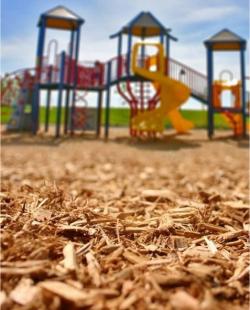 Loose-fill surfaces such as EWF (engineered wood fiber) are generally less expensive, do not require professional installation, drain well and give good fall height protection. EWF are safe and technically ADA compliant but require an even and deep distribution. Loose-fill surfacing materials get kicked away from under the swings and from the bottom of the slide, which means someone has to rake, level and replenish the material regularly. People using wheelchairs will find loose-fill inaccessible especially if it is not raked at least weekly. Loose-fill surfaces such as EWF (engineered wood fiber) are generally less expensive, do not require professional installation, drain well and give good fall height protection. EWF are safe and technically ADA compliant but require an even and deep distribution. Loose-fill surfacing materials get kicked away from under the swings and from the bottom of the slide, which means someone has to rake, level and replenish the material regularly. People using wheelchairs will find loose-fill inaccessible especially if it is not raked at least weekly.Does not meet MAAB standards. |
| Attachment | Size |
|---|---|
| 9 MB | |
| 1.28 MB | |
| 210.2 KB | |
| 337.97 KB | |
| 5.86 MB | |
| 600.2 KB | |
| 566.55 KB | |
| 1.02 MB | |
| 197.15 KB | |
| 42.55 KB | |
| 32.94 KB | |
| 97.6 KB | |
| 57.45 KB | |
| 157.59 KB | |
| 86.66 KB | |
| 23.74 KB | |
| 463.67 KB | |
| 343.4 KB |


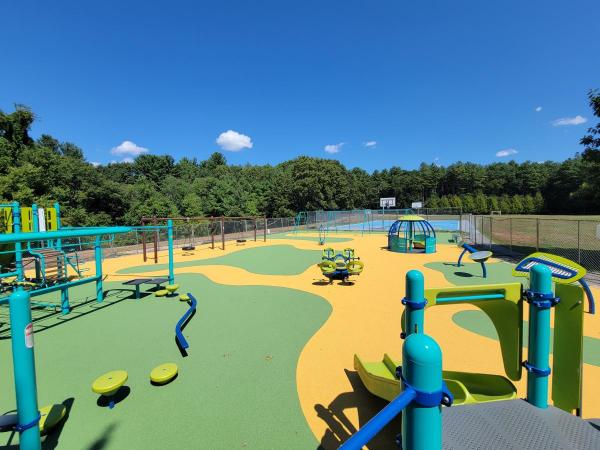
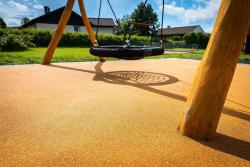 Cork has been proposed as a poured-in-place and polyurethane mix that may become available in the United States in 2020.
Cork has been proposed as a poured-in-place and polyurethane mix that may become available in the United States in 2020.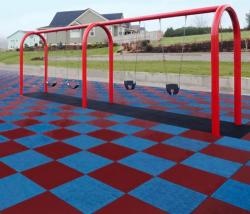 Accessible and safe when installed over a cushioned base; however, the edges can be prone to curling. This surface costs about the same, initially, as poured-in-place and requires little maintenance.
Accessible and safe when installed over a cushioned base; however, the edges can be prone to curling. This surface costs about the same, initially, as poured-in-place and requires little maintenance.